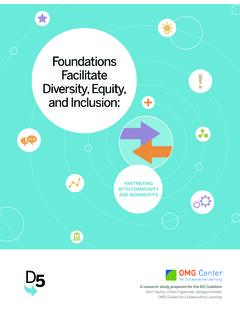Transcription of SO YOU WANT TO COLLECT DEMOGRAPHIC …
1 2015 SO YOU WANT TO COLLECT DEMOGRAPHIC DATA: GETTING STARTED This brief provides tips to help your organization get started with collecting and using DEMOGRAPHIC data an essential tool for understanding the impact of your work. Please note that we include tips for both nonprofits and foundations as many of the guiding principles apply to both types of organizations. Some tips specific to foundations are provided, as well. These are broad areas to explore, and how deep and wide you go with each will depend on your organization and the journey you take with this work. Take it from us, it might be tempting to jump right in and start compiling numbers, but take your time be sure to lay the groundwork to set your organization up for success. Some recommended steps: Establish at the board and executive management levels a strong authorizing environment for engaging in diversity, equity, and inclusion (DEI) conversations and practices Make sure you have an organizational commitment in place to talk about issues of DEI, and to explore what they mean in practice.
2 It could take six months to a year to get people comfortable with the process. This is time well-spent because you have to be sure your organization is clear on the value of DEI work before moving to implementation and external messaging. As an organization, talk about and articulate what DEI means to your organization, and what it means to put it into practice. Clarify and express your internal and external message about why DEMOGRAPHIC data is important to your organization This, too, may take a while as it may surface internal issues and concerns that have to be discussed about how data brings value to your organization, and how it connects to your organization s values related to DEI. Be sure everyone within your organization understands it before expressing it outwardly. Put in writing why it s important (for example: we are committed to diversity, equity, and inclusion, and we view data as an essential tool to practice this commitment).
3 What data will you COLLECT and share? Data about your programs, staff, board, vendors? What level of detail? (note: ideas about what to ask are included in #5) For foundations: If you re interested in asking your grantee partners to share DEMOGRAPHIC data, are you collecting and sharing your own data? It s tough to ask others to do something that you re not doing, so build your organization s commitment to sharing its own DEMOGRAPHIC data, explore how best to do it, and get started. 2015 Explain why you are asking for DEMOGRAPHIC data and what you will do with it internally and externally Asking for data about personal information naturally raises questions about why an organization is seeking the data and how it will be used. Be sure you can answer those questions. o The California Endowment writes: The data collected will serve multiple purposes: to help us understand how we reflect the communities we serve, to equip our staff with critical data to better serve the needs of our communities, and to track our progress with our Board and our grantees and communities.
4 For foundations: Determine standards for collection) Foundations need to determine a couple of key things: o Voluntary vs. mandatory: Will you ask for voluntary data or require it of your grantee partners? o Pre-award vs. post-award: Will you ask for data before awarding a grant or after awarding a grant? There is not a right or wrong answer to these questions what s best for your foundation in light of where your foundation and your grantee partners are on the journey and how the data will be used? Ask the right questions Recommended standards: What s the best way to ask for information? Thankfully, a lot of legwork has been done. Check out the GuideStar Nonprofit Profiles ( ) and the Foundation Center ( ) for recommended standards for asking about populations and for coding grants. Legal issues: Is it legal to ask about demographics? Short answer: yes. But be sure you re doing it in a way that protects everyone s rights and privacy.
5 Check with your own legal advisors and HR department as it s important to do this right for your organization. Operational considerations Decide what data you ll COLLECT and how you ll COLLECT it and do it at the scale that s right for you. How will you put data collection into practice? Run an online survey? Email a questionnaire? Distribute paper copies? Store the data in a database (grants or otherwise)? Use GuideStar? Most likely, you ll get started and you ll change how you go about it over time. Learn what s right for you, which often happens by doing. Get started, share what you learn, refine and keep going As you get started in your learning, reach-out to colleagues who have similar experiences based on your type and size of organization or foundation. Build in time as an organization to reflect on the process, to extract lessons from the data, and to use it in your work. Make the changes you need as you need them, and keep going!
6 Promoting and practicing diversity, equity, and inclusion is not simple. It requires planning, patience, and a willingness to learn from and share failures. Get started, stick with it, and keep going! Special thanks to our colleagues at The California Endowment for sharing their many lessons learned and tips for DEMOGRAPHIC data collection.







